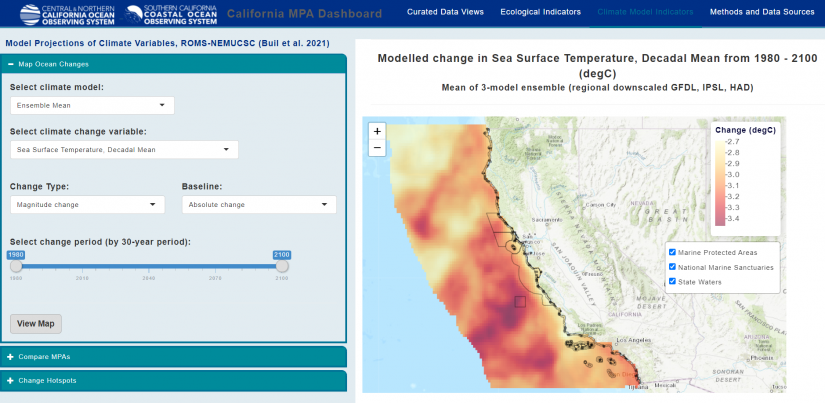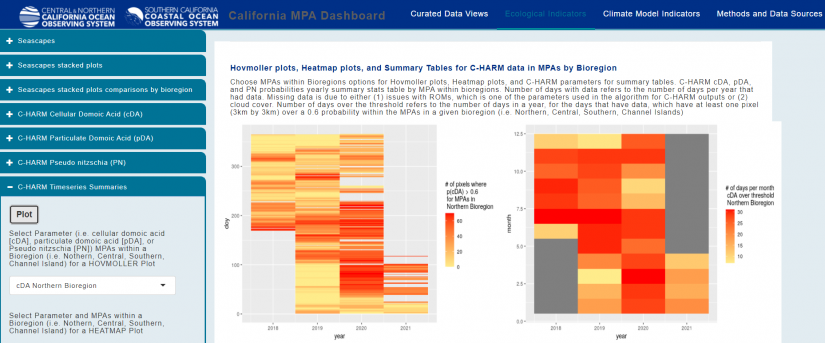Marine Protected Areas face many pressures, from resource use to climate variations and long-term change, but monitoring their effectiveness is difficult for managers because of wide variation over both daily and decadal timescales.
There are a myriad of natural and anthropogenic conditions that can impact Marine Protected Areas (MPAs). Where can resource managers find the information needed to make informed decisions all in one place? The team, funded by the Ocean Protection Council and California Sea Grant through the Marine Protected Area Monitoring Program, is working on the answer, and one that can be accessed freely online. They are creating an app that features curated, up-to-date datasets to help resource managers make informed decisions based on a confluence of the latest research and historical data.
Their goal is to create a user-friendly tool where researchers and MPA managers can answer questions about the overall condition of California MPAs at a glance. The app will be a “one-stop-shop” with a dashboard where the most recent raw data, archives, and standardized long-term ecological data from California’s oceans can be downloaded and used by MPA managers for their own analysis. The app is currently in its prototype stage, but will be publicly available later this year.
So far, the team has compiled existing data sets from many different sources, including the Southern California Coastal Ocean Observing System (SCCOOS), the Central and Northern California Ocean Observing System (CeNCOOS), and other data continues to be added. Some environmental and biological data comes from satellites and advanced remote sensing tools like moorings, buoys, radar, and sensors. Other data is sourced from researchers in the field. By combining diverse datasets, the app will create a current snapshot of MPA physics, biogeochemistry, biology, and ecology, and also model future scenarios.

Researchers at Scripps Institution of Oceanography at UC San Diego, the Monterey Bay Aquarium Research Institute (MBARI), UC Santa Cruz, and Axiom Data Science are working together to create these high-resolution modeling tools. The models will highlight the impacts of increased sea surface temperatures, variations in ocean acidity, dissolved oxygen, nutrients, and climate-related ecological phenomena such as harmful algal blooms and marine diseases, all of which can impact the California coast and the network of 124 MPAs. The diverse team of scientists is taking a multipronged approach to process complex data to make it easily accessible for the resource managers.
“One of the key issues we are aiming to tackle here is helping MPA investigators and others understand the potential drivers for change in MPAs. These can of course come with fishery management actions, as well as natural variations with climate and/or climate change,” said Henry Ruhl, CeNCOOS director and the project’s principal investigator.
A major challenge is formatting the datasets so that they can be viewed in a cohesive and understandable way for the app users. The team is working with other experts from broader MPA research programs to create novel ways to integrate the data and process it quickly so that the information provided in the app is as close to real-time as possible.
“This kind of interdisciplinary project requires a lot of communication amongst the teams in order to efficiently gather the data from everyone and to format it in a way that can both be archived for future use and also be fed in our Shiny R statistical application,” says Florybeth La Valle, postdoctoral scholar with California Sea Grant and SCCOOS. “It has been a wonderful way to get to know all the different teams and work together in order to create a product that can be useful to as many groups as possible.”

The app will be used by California’s decadal MPA network advisory team to answer questions about MPA conditions and management, and climate change risk. The team expects that the tool will be used to inform the advisory committee on their suggestions for MPA management decisions.
This project is one of seven funded by the Ocean Protection Council and California Sea Grant through the Marine Protected Area Monitoring Program. The $9.5 in funding supports large collaborative projects that include researchers at 24 universities, agencies, and institutions in the state. Many of the funded projects are nearing completion, and their research builds upon data collected during the MPA Baseline Monitoring Program, which ran from 2007-2018.
About California Sea Grant
NOAA’s California Sea Grant College Program funds marine research, education and outreach throughout California. Headquartered at Scripps Institution of Oceanography at the University of California San Diego, California Sea Grant is one of 34 Sea Grant programs in the National Oceanic and Atmospheric Administration (NOAA), U.S. Department of Commerce.